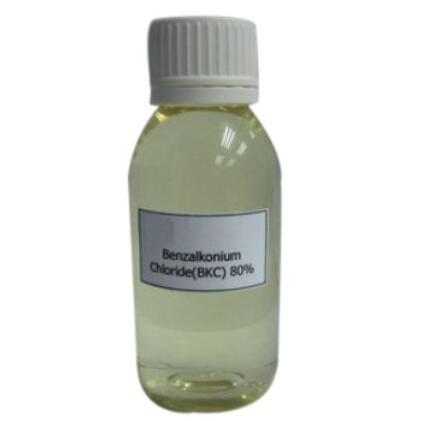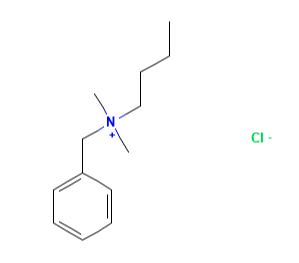Benzalkonium chloride
General description
Benzalkonium chloride (BACs) is a common bactericidal disinfectant, its main component is dodecyl dimethyl benzyl ammonium chloride (DDBAC). BACs are the most common active ingredients in disinfectants and are widely used in households, agriculture, industry and clincal study. Household applications include fabric softeners, phase transfer agents, personal care products and beauty products such as shampoos, conditioners and body lotions, as well as band-aids, ophthalmic pharmaceutical preparations and nasal sprays. In the United States, BACs are used on indoor and outdoor surfaces (walls, floors, toilets, etc.), agricultural tools and vehicles, humidifiers, water storage tanks, residential and commercial pools, decorative ponds and fountains, water pipes and systems, pulp and Disinfection and preservation of paper products and wood. Due to the massive use of disinfectants, the current global disinfectant market, including BACs, is expected to grow by more than 6% over 2016 and reach USD 8 billion by 2021.
BACs are widely used in household goods, pharmaceutical products and aquaculture. Therefore, BACs will inevitably enter the environment, have toxic effects on aquatic organisms, plants and even humans in the environment, and pose a potential threat to the entire ecosystem. As the last barrier before BACs are discharged into the natural environment, sewage treatment plants are an important place to remove BACs in wastewater and play a vital role in reducing the environmental risks of BACs.[1]
Figure 1 the molecular formula of Benzalkonium chloride
Application and pharmacokinetics
1.With regard to the degradation of BACs in environmental media and the drug effects of BACs, there are few studies on their biosorption and biodegradation mechanisms in the water treatment process, and there are few reports on the research on their migration and transformation processes, and BACs as a kind of An effective fungicide has a killing effect on various pathogenic microorganisms, but lacks selective toxicity and poor target specificity. When it enters the sewage treatment plant together with wastewater, it may affect various microorganisms in the activated sludge. Produce adverse effects, thereby affecting the performance of the entire biological treatment system
2.The FDA Division of Pulmonary/Allergy Drugs to look into this issue. It is noteworthy that while CNA is a standard treatment in the US, it is not FDA approved for this use(i.e. off label).
3.Glaucoma patients routinely take multiple medications, with multiple daily doses, for years or even decades. Benzalkonium chloride is the most common preservative in glaucoma medications. Benzalkonium chloride has been detected in the trabecular meshwork (TM), corneal endothelium, lens, and retina after topical drop installation and may accumulate in those tissues. There is evidence that Benzalkonium chloride causes corneal and conjunctival toxicity, including cell loss, disruption of tight junctions, apoptosis and preapoptosis, cytoskeleton changes, and immunoinflammatory reactions. These same effects have been reported in cultured human TM cells exposed to concentrations of Benzalkonium chloride found in common glaucoma drugs and in the TM of primary open-angle glaucoma donor eyes.It is possible that a relationship exists between chronic exposure to Benzalkonium chloride and glaucoma. The hypothesis that BAK causes/worsens glaucoma is being tested experimentally in an animal model that closely reflects human physiology.[2]
Synthesis
At present, the synthesis of benzalkonium chloride mostly uses dodecyl alcohol to synthesize dodecyl bromide, then react with dimethylamine to obtain dimethyl dodecylamine hydrogen bromide, and finally react with benzyl chloride to obtain benzalkonium chloride. , The obtained benzalkonium chloride is mostly industrial grade, which is difficult to be applied in the medical field. Alkyldimethylamine and benzalkonium chloride must be refined before pharmaceutical-grade benzalkonium chloride is prepared. The production method is complicated and requires high equipment and equipment. Many pharmaceutical benzalkonium chloride product manufacturers cannot prepare benzalkonium chloride. Ammonium chloride increases the cost of benzalkonium chloride pharmaceutical products.
Toxicological and Safety
Oral BACs can cause significant mortality in mammals. Choi et al. [4] used a whole body cavity system and aerosol inhalation system to evaluate the toxicity of DDBAC to rat respiratory exposure. It was found that when the DDBAC exposure concentration was 20 mg·m3, the rats experienced deep breathing, hoarseness, and runny nose with the decrease in food intake and weight. When the DDBAC exposure concentration was 0.8 mg·m3 and 4 mg·m -3, The rats also had a runny nose. And histopathological examination showed that the nasal cavity and lung cells of the three groups of mice had changes. Lavorgna et al. [5] studied the toxicity and genotoxicity of BACs by using two freshwater crustaceans, Daphnia and Daphnia, as models. The results showed that the Lethal Concentration 50 (LC50) of BACs to Daphnia reticulatus was 403.7 μg·L1 (acute, 24 h), and the Median Effect Concentration (EC50) of BACs to Daphnia magna was 38.2 μg·L.
One to four hour exposures compared with the brief intermittent daily clinical exposures. In the inhalation study where marked adverse respiratory findings were noted, the estimated doses were in excess of 10,000-fold of the clinical doses. In the absence of a double-blind, randomized study and based on the compelling evidence that high doses of BAC exert a detrimental effect on airway function, we recommend that the preservative-free products be used in a large volume nebulizer. [3]
Storage and Safty
Storage of benzalkonium chloride: Store in a cool, dry, and well-ventilated warehouse. Keep away from fire and heat sources. The humidity in the warehouse is preferably not more than 85%. The packaging must be sealed and protected from moisture. It should be stored separately from easily (combustible) combustibles, acids, etc., and avoid mixed storage. The storage area should be equipped with suitable materials to contain the leakage. Check in real time whether all labels are clear and leak-free.




